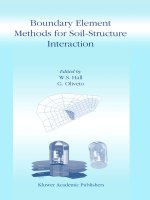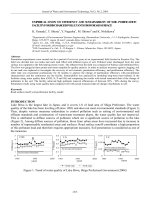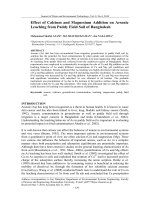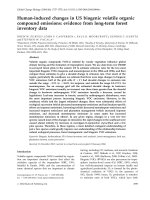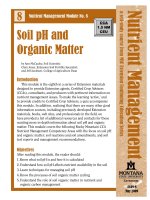Earthquake induced soil liquefaction
Bạn đang xem bản rút gọn của tài liệu. Xem và tải ngay bản đầy đủ của tài liệu tại đây (5.81 MB, 70 trang )
EARTHQUAKE-INDUCED SOIL LIQUEFACTION:
MOST DETRIMENTAL SEISMIC GROUND FAILURE
Nien-Yin Chang (NYC), Ph.D., P.E.
Professor of Geotechnical Engineering and
Director of Center for Geotechnical Engineering Science
University of Colorado Denver
Largest earthquakes since
1900
Date UTC Magnitude
Location
Chile
1964 Great Alaska
Earthquake
Off the West Coast of
Northern Sumatra
Near the East Coast of
Honshu, Japan
Kamchatka
Offshore Maule, Chile
Off the Coast of Ecuador
Rat Islands, Alaska
Northern Sumatra, Indonesia
Assam - Tibet
Off the west coast of northern
Sumatra
Andreanof Islands, Alaska
Southern Sumatra, Indonesia
Banda Sea, Indonesia
Kamchatka
Chile-Argentina Border
Kuril Islands
Updated 2012 April 11
Lat.
Long.
Reference
1960 05 22 9.5
1964 03 28 9.2
-38.29 -73.05 Kanamori, 1977
61.02 -147.65 Kanamori, 1977
2004 12 26 9.1
3.30
2011 03 11 9.0
38.322 142.369 PDE
1952
2010
1906
1965
2005
1950
2012
52.76
-35.846
1.0
51.21
2.08
28.5
2.311
11
02
01
02
03
08
04
04
27
31
04
28
15
11
9.0
8.8
8.8
8.7
8.6
8.6
8.6
1957 03 09 8.6
2007 09 12 8.5
1938 02 01 8.5
1923 02 03 8.5
1922 11 11 8.5
1963 10 13 8.5
95.78
160.06
-72.719
-81.5
178.50
97.01
96.5
93.063
Park et al., 2005
Kanamori,
PDE
Kanamori,
Kanamori,
PDE
Kanamori,
PDE
1977
1977
1977
1977
51.56 -175.39 Johnson et al., 1994
-4.438 101.367 PDE
-5.05
131.62 Okal and Reymond,
2003
54.0
161.0
Kanamori, 1988
-28.55 -70.50 Kanamori, 1977
44.9
149.6
Kanamori, 1977
DEFINITION OF SOIL LIQUEFACTION
In a soil mass, total stress (σ), pore water pressure (u) and effective stress (σ’) are
related as in the following equation:
𝝈 = 𝝈′ + 𝒖, 𝒊. 𝒆.
𝝈′ = 𝝈 − 𝒖
When a loose saturated soil are subjected to dynamic load, like earthquake
shaking,
•
Excess pore water pressure increases as the dynamic load progresses.
•
The total stress remains constant, while the effective stress continues to decrease
till pore water pressure equals total stress and the effective stress becomes zero.
•
Since the strength of sand is a monotonically increasing function of effective
stress, when the effective stress becomes zero, the soil experiences a complete
loss of strength and,
•
Gross lateral spreading occurs.
The phenomenon is called soil liquefaction.
TERZAGHI’S EFFECTIVE STRESS PRINCIPLE
Before seismic shaking
Total Stress = Effective Stress + Hydrostatic Pore Water
Pressure, i.e.
= ’ + uo
During seismic shaking
σ = ’ + uo + u, i.e.
’ = - (uo + u) = - u
When ' goes to zero, the soil liquefies, its strength goes
to zero, and the soil flows like a liquid.
FIGURE XX STRESS-STRAIN AND PORE PRESSURE RESPONSES OF SATURATED SANDS
IN MONOTONIC TRIAXIAL TESTS (DEPARTMENT OF THE ARMY)
Figure xx load, deformation, and pore pressures records during a cyclic triaxial test
(Department of the Army, 1990)
Figure xx Cyclic triaxial strength curves for Monterey No.0 Sand (USAE, 1990)
EFFECTS OF LIQUEFACTION:
MOST DETRIMENTAL FORM OF GROUND FAILURE
Shallow Foundation Support: Because of the gradual increase of
excess pore water pressure and constant overburden pressure
during earthquake shaking, the effective stress continues to
decrease and eventually becomes zero and the soil experiences
complete loss of shear strength and its capacity to support
superstructures. This bearing capacity failure results in drastic
dislocation and settlement of buildings on shallow foundations
during the seismic shaking, as depicted in the apartment building
failures in Niigata, Japan in 1964.
Deep Foundation Support: Superstructures supported on deep
foundations, however have a much better chance of survival,
although many buildings still suffered excessive lateral dislocation
and many bridges suffered sequential and progressive falls of one
end of bridge deck into river due to differential side sway
between neighboring bridge piers.
CYCLIC STRESS RATIO AND CYCLIC RESISTANCE RATIO
•
Cyclic Stress Ratio (CSR) = cyclic maximum shear stress /
effective overburden (or confining) pressure
1. Cyclic shear stress =0.65 x rd x max shear stress (Seed),
where rd = rigidity reduction factor
2. Max Shear stress = mass of a soil column of unit area x peak
ground acceleration from MCE
•
Cyclic Resistance Ratio (CRR) = cyclic maximum shear stress /
effective confining pressure
1. CRR determined in laboratory cyclic triaxial (cyclic simple
shear or cyclic hollow cylinder) tests
2. CRR from adjusted BPF (N1)60 from field SPT
Liquefaction failure occurs, when CRR ≤ CSR, where CRR
IS OBTAINED FROM:
1.
FIELD OBSERVATION CURVES OF SEED BASED ON THE ADJUSTED BPF
VALUES, (N1)60 OR LABORATORY TRIAXIAL TESTS.
2.
CYCLIC SHEAR STRESS RATIO(CSR) IS OBTAINED USING THE
MAXIMUM SHEAR STRESS FROM ONE-DIMENSIONAL WAVE
PROPAGATION ANALYSIS USING SHAKE 2000 OR Cyclic shear
stress (CSR) = 0.65 x rd x max shear stress/σvo’, where rd =
rigidity reduction factor and maximum shear stress = m x ap (=
peak ground acceleration).
3.
Factor of Safety against liquefaction = CRR/CSR
BPF OF PENETRATION
•
Measured BPF are called N
•
Adjusted N to standard conditions is called N1(60)
•
Adjusted N1(60) to clean sand conditions is called
N1(60) cs
RELATION
BETWEEN N1(60)CS
& CSR
(OR CRR)
FOR A 7.5M
EARTQUAKE
PROCEDURE FOR LIQUEFACTION ANALYSIS
•
Determine: if the earthquake has potential to produce
soil liquefaction, if the soils are susceptible to
liquefaction then
•
Determine if liquefaction may occur using the Seed
simplified method
•
If yes, verify if the earthquake will produce higher
stresses (CSR values) than the soil strength can take it
(CRR values) using SHAKE for the CSR
EMPIRICAL DETERMINATION OF LIQUEFACTION POTENTIAL
Liquefiable zone
Non-liquefiable
zone
LIQUEFACTION ANALYSIS USING SEED SIMPLIFIED METHOD
•
COMPARES STRENGTH WITH STRESSES
•
DETERMINE SOIL STRENGTH
• Obtain SPT data (N and soil parameters)
• Adjust N to standard conditions for clean sands and
convert to CRR values if needed
•
DETERMINE SOIL STRESSES
• Calculate CSR earthquake induced by the MCE,
and convert to equivalent N values for clean sands
Factors affecting liquefaction of soils
Many factors influence the potential for soil liquefaction, including
lab factors and field factors. While laboratory tests can’t reproduce
the field liquefaction behavior of soils, they are used to research the
factors affecting liquefaction of soils because of the capability of
reproducing near identical samples of high quality. This makes
possible the evaluation of the influence of different factors on
liquefaction of soils.
DEFINITION OF SOIL LIQUEFACTION
LABORATORY TESTS FOR SOIL LIQUEFACTION
Many different laboratory experiments can be used to
evaluate the liquefaction resistance of soils:
1.
cyclic triaxial tests, most popular
2.
cyclic simple shear tests, most capable of simulating
dynamic simple shear conditions in earthquake
shaking, but their stress and strain distributions are far
from uniform, and
3.
cyclic hollow cylinder tests, the best test, but difficult to
prepare samples.
4.
shear wave velocities measured during cyclic tests
can be related to liquefaction resistance of soils.
FIGURE XX STRESS-STRAIN AND PORE PRESSURE RESPONSES OF SATURATED SANDS
IN MONOTONIC TRIAXIAL TESTS (DEPARTMENT OF THE ARMY)
Figure xx load, deformation, and pore pressures records during a cyclic triaxial test
(Department of the Army, 1990)
Figure xx Cyclic triaxial strength curves for Monterey No.0 Sand (USAE, 1990)
LAB FACTORS AFFECTING LIQUEFACTION RESISTANCE
1.
Sample factors:
Sample disturbance; Relative density; Fines contents and
plasticity; Grain Size and shape; Sample size; Gradation
characteristics
2.
Imposed factors:
Aging and cementation; sample preparation methods;
reconstitution; wave form, amplitude and frequency; cap
and base friction; membrane Compliance; OCR,
confining pressures; anisotropic consolidation ratio, and
pre-straining.
DIFFERENT FIELD TESTS FOR LIQUEFACTION
RESISTANCE OF SOILS
1.
Field shear wave velocity measured from cross-hole,
down-hole and up-hole tests can also be used to
assess the liquefaction resistance of soils.
2.
Standard penetration tests (SPT) and cone penetration
tests (CPT) are two most popular types of field tests for
assessing the liquefaction potential of soils without
actually performing cyclic tests.
Fig.xx Liquefaction Resistance vs Fines Content for Nl=20
FIELD FACTORS AFFECTING LIQUEFACTION
RESISTANCE OF SOILS
1.
earthquake intensity and duration,
2.
ground water table,
3.
drainage condition,
4.
field relative density,
5.
grain size distribution,
6.
fines contents, liquid limits, and plasticity index,
7.
history of liquefaction of soils in previous earthquakes, and
8.
geological aging history of soil deposits
9.
Placement condition and method
10.
Building load
